Posting Introduction
http://en.wikipedia.org/wiki/Celts
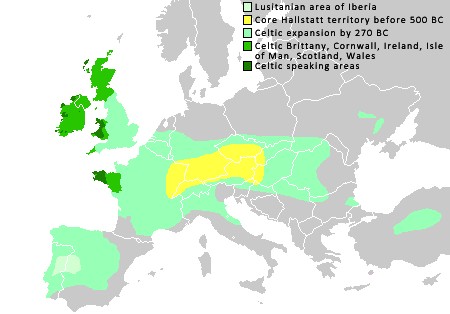
Celticization from the West sketches a picture of Celtic people in the West, describing Celts from the time of their sudden appearance in Iberia, their Bell Beakers and LaTene phases, and sudden demise in the 1st mill. BC; signally, the archeological review does not mention the sedentary Urnfield and Hallstatt at all, the Urnfield is unrelated, and Hallstatt is aborigines dominated by Celts. The offered synopsis of the Celtic migration and spread provides a concise account of the developments on the European scene. In 1700 years, by the end of the 2nd mill. BC, Celtic people expanded to populate half of the Europe, reaching to their old homeland in the N. Pontic. The Celtic expansion mimicked the expansion of the preceding “Pre-Kurgan cultures” in the N. Pontic, and the expansion of the later Türkic confederations of the Huns, Avars, and numerous Türkic states. But anyone who would follow the ideas of Wikipedia (2014) http://en.wikipedia.org/wiki/Celts and http://en.wikipedia.org/wiki/Celtic_languages would walk away with an impression that the Celts were born Indo-European, spoke Indo-European from the day they were born, and were Christianized centuries before Virgin Mary first discussed perspectives on her progeny with a double-winged messenger. Any reader of the following article would be puzzled by Wikipedia's supersession of most substantial information by minutia interspersed with rhetorical fluff. Anyone familiar with the Türkic ethnology would recognize in Celts the well-known Türkic idiosyncrasies stuck with them like the aroma of rotten fish. The mound of attestations contains ethnological and linguistic observations, and genetic conclusions. The mounds of traced and attested material dwarf autochthonous flights of fantasy cracking gates to the murky layers of our past, the fanciful extensions of reality that may never be verified. The outline of some R1b migrations is cited below, from A. Klyosov http://aklyosov.home.comcast.net (http://www.lulu.com/items/volume_71/10723000/10723072/2/print/10723072.pdf), History of R1b Haplogroup from Central Asia to Europe, starting on page 1131:
“After haplogroup R1 arose about 23,000 years ago, and its downstream R1b arose in Central Asia 16,000 ago, the latter had migrated across North Kazakhstan (including the later Botai archaeological culture, 6500-5500 ybp), through the territory of the present-day Bashkirs (13-11-8 thousand ybp), established Seroglazovo archaeological culture (13-11 thousand ybp) and then Middle Volga Basin archaeological cultures (Middle Volga culture 8-7 thousand ybp; Samar culture 7 thousand ybp; Sredny Stog culture 7500-5500 ybp; Khvalyn culture 7 thousand ybp, Kama culture 7-5 thousand ybp), that is the cultures (tentatively) named “Pre-Kurgan cultures”; the subclade R1b1a2-M269 arose around 7,000 ybp, and then around 6,500 ybp arose R1b1a2-L23. Around 6,500-6,000 ybp, and possibly earlier both of them came to the Caucasus region. Those R1b1b spoke non-Indo-European language(s), now they can be vaguely traced under various names. Some call them Proto-Türkic language, some call them Sino-Caucasian language, Paleo-Eurasian language, Erbin language (because of R1b haplogroup of their bearers), Western or North-Western Caucasian languages; some call them Vasconic language and find some similarities between the Caucasian and Basque languages, etc. In fact, those similarities do exist, albeit in a rather weak form because thousand of years passed since then. Still now most of R1b1a2 haplotypes in the Caucasus (in Armenia, Dagestan, Georgia) belong to the ancient L23 subclade (with common ancestor in the Caucasus of around 6,000 ybp), and have a characteristic DYS393=12 allele, unlike DYS393=13 in most of European R1b1b2 haplotypes.
From the Caucasus, R1b1a2-L23 and R1b1a2-M269 bearers went South over the mountains, to Anatolia (a common ancestor of 6,000 ybp), and then split into three major routes. One went further South, to Tigris and Euphrates Rivers, and became the Sumers. Many present-day Assyrians, descendants of ancient Sumers, still have their R1b1a2 haplotypes. Another went westward, across Asia Minor, and came to Europe, to the Balkans and Mediterranean Sea region around 4500 ybp. The third group went across Northern Africa and Egypt (and incidentally, might have left some R1b1b2 Pharaohs there) to the Atlantic and went across Gibraltar to the Iberian Peninsula around 4800 ybp. They became the Bell Beakers, and moved up North into the continental Europe. The Bell Beaker culture in Europe had lasted between about 4400 and 3800 ybp.
Apparently, the R1b1a2 bearers came to the Pyrenees as mainly L51/M412 and/or L11/L151/P310 subclades, and soon split there into U106 and P312 downstream subclades, which went to the continental Europe as said Bell Beakers with downstream subclades such as U198, U152, L2, L20, L4, L21, M222, L226 SRY2627, etc. They left the Basques behind, who still maintain the ancient R1b language, similar in kind with some Caucasian languages and with the Sumer language, and with some elements of Proto-Turkic languages ascending back to Asia and further to Siberia.
Until the beginning of the 1st millennium BC, the R1b1a2 language in Europe was predominantly (or only) non-Indo-European (non-IE). There is not a single solid evidence of otherwise, that R1b1a2 in Europe spoke an IE language before the 1st millennium BC. For instance, linguists place the Celtic language and “Proto-Celtic” language not earlier than 800-900 BC, and all more earlier placements are typically groundless.”
So far, not all migrations had been detected and identified, and some archeological cultures appear to be misidentified; the Celtic presence in Europe is dated from as far as 8000 ybp to 2900-2800 ybp. Right there falls the archeological Tumulus Culture, distinguished by the practice of burying dead in kurgan (tumuli) cemeteries; its distinction points to the migration of the Kurgan Culture people ca. 3600 to 3200 ybp. Those nomadic migrants may had created the image of the Celts that is now extended to a larger body of peoples from separate migration waves. The people kindred to the prior migrants who reached Central Europe likely came from numerous directions and at various times, and may have recognized their kinship only in a fraction of encounters, being separated by wide timespans, incompatible routes, and linguistic changes. The very name Celt is a conditional name, fairly recently attributed to a specific families of peoples. Perspectives of this work are huge, they involve genetics and biology at large, archeology, linguistics, history, art, culture, and technology.
Besides the findings of the DNA-genealogy and numerous ethnological parallels with the modern descendents of the Central Asian nomads, two traits attract attention. The Celts are known for their light-hair, a rare trait in the history of humanity. That genetic trait belongs to two easily discriminated populations, the “northern Eurasians” i.e. the Finns of the Y-DNA haplogroup NO-type with a unique mutation, and Papuans/Melanesians of the Y-DNA haplogroup D with a unique ASPM mutation; it is transmitted to the future generations in the directional and restricted genetic exchange, the presence of fair hair and light eyes requires quite specific ancestors. Apparently, the genes for the light hair and eyes accumulated among the northern Türkic people who coexisted and admixed with Fennic people, along the lines described by T. Chikisheva Anthropology of SW Siberians. The second curious trait is the specific textile shared by the Celtic people with the ancient Tarim population (currently mislabeled “Tocharian”). The Caucasoid remains found in the Altai royal kurgans and in the Tarim basin (see Zhou portrait) were all found to be consistent with the modern Uigur or South Siberian Türkic population, and annalistic records depict the Türkic tribes of Tele, Dinlins, Usuns, Saklans, and Kirgiz as fair hair and light eyed. With the Saklans, Saka, and Scythians, the Scots share the anlaut S'k, possibly with the Türkic plural affix “ty”.
 The
etymology of the names is always a contentious issue. Unless the meaning and the original language
of a name are absolutely transparent (Brown means “brown”), the etymologies of the names are and
should be questioned. Numerous Celtic names
do not have a credible IE etymology, while the Türkic etymology appears straight-forward, feasible,
and credible. In places, the Türkic etymology is the only one suggested, with no alternatives. In places
Türkic etymologies allow to derive purportedly IE etymology from the Türkic substrate: land,
man, son, alms, arch, and many more. In the paradigm of the IE pra-language, the Celtic languages
are prominently absent as
reconstruction models, for obvious historical reasons nobody tries to fancy a PIE *proto-word from the Breton language, albeit
the canonical PIE diagram squarely puts the Celtic languages equidistant with the Romance and
Germanic languages popular among the western linguists. More than that, a reconstruction of the PIE from
the Celtic languages would give you a *language that has little in common with the accepted *reconstruction of the *PIE
*language.
(http://www.breizh.net/icdbl/saozg/Celtic_Languages.pdf,
click to enlarge). The linguistic Indo-Europeoidness of the Celts is so shallow that it covers no
more than a small patch on the surface of the Celtic languages, demonstrated by a sample test in the
list from the same source. Not only the roots are the old Türkic roots, but the traces of morphology
are also there, the Celtic personal affix -im agglutinated to the root is a form of the same
affix -im and -um of the old and new Türkic languages. Of the 12 samples, 8 or 2/3rd
ascend to the Türkic words. The other 1/3rd may or may not have an IE relation. This is an anecdotal
evidence, but nevertheless it is telling.
The
etymology of the names is always a contentious issue. Unless the meaning and the original language
of a name are absolutely transparent (Brown means “brown”), the etymologies of the names are and
should be questioned. Numerous Celtic names
do not have a credible IE etymology, while the Türkic etymology appears straight-forward, feasible,
and credible. In places, the Türkic etymology is the only one suggested, with no alternatives. In places
Türkic etymologies allow to derive purportedly IE etymology from the Türkic substrate: land,
man, son, alms, arch, and many more. In the paradigm of the IE pra-language, the Celtic languages
are prominently absent as
reconstruction models, for obvious historical reasons nobody tries to fancy a PIE *proto-word from the Breton language, albeit
the canonical PIE diagram squarely puts the Celtic languages equidistant with the Romance and
Germanic languages popular among the western linguists. More than that, a reconstruction of the PIE from
the Celtic languages would give you a *language that has little in common with the accepted *reconstruction of the *PIE
*language.
(http://www.breizh.net/icdbl/saozg/Celtic_Languages.pdf,
click to enlarge). The linguistic Indo-Europeoidness of the Celts is so shallow that it covers no
more than a small patch on the surface of the Celtic languages, demonstrated by a sample test in the
list from the same source. Not only the roots are the old Türkic roots, but the traces of morphology
are also there, the Celtic personal affix -im agglutinated to the root is a form of the same
affix -im and -um of the old and new Türkic languages. Of the 12 samples, 8 or 2/3rd
ascend to the Türkic words. The other 1/3rd may or may not have an IE relation. This is an anecdotal
evidence, but nevertheless it is telling.
| English | Turkish | Türkic | Root | Gaelic | Manx | Welsh | Cornish | Breton |
|---|---|---|---|---|---|---|---|---|
| I hear to go dog sea language house bread black white young old without |
duyuyorum gitmek için (go I) köpek deniz dil ev ekmek siyah beyaz genç eski olmadan |
ešittim gid-/git- köpäk si til turuɣ büškäč, esbari, yarma – – yaš qan bisiz |
qulak = ear gid-/git- kö- – til tur- büš, bari, yarm – – yaš qan – |
cluinim dhul cu muir teanga teach aran dubh ban og sean gan |
cluinym goll co muir chengey thie arran doo bane aeg shenn gyn |
clywaf mynd ci more iaith ty bara du gwyn ieuanc hen heb |
clewaf mones kt more yeth chy bara du gwyn yowynk hen hep |
klevan mont ki mor yezh ti bara du gwenn yaouank hen hep |
This publication makes deserving strides to reduce the lamentable impression that the Celtic history suffers the same disease that in particular inflicted Russian, and in general the Slavic history, a malady of distortion, when the present evidence is ignored, inconsistencies whitewashed, blind eye is turned, and history is written not by scholars, but by partisans impersonating scholars. So far, it appears that the Celtic history was robbed and deprived of its rich past, the Celtic people were mislead about their colorful genealogy, and the Celtic dynasts were denuded of their glorious ancestors. The genetic evidence might shed some light on the missing pages, and archeological, literary, and historical evidence fill the missing pages. In terms of the Celtic archeology, the Beaker Culture's language is called Celtic, and not Italic. The Kurgans' circum-Mediterranean path via Pyrenees to the Continental Europe brought about the Beaker Culture, ancestral to the Pra-Celts and Pra-Italics.
Page numbers are shown at the beginning of the page. The subheadings in bold blue, highlighting, the posting's notes and explanations added to the text of the author and not noted specially, are shown in parentheses in (blue italics), in blue boxes, or under blue headings.
Celtic from the West: alternative
perspectives from archaeology, genetics, language, and literature
CONTENTS
| Introduction - Barry Cunliffe & John T. Koch | I | |
| Part I: Archeology | ||
| 1. | Celticization from the West: The Contribution of Archaeology - Barry Cunliffe | 11 |
| 2. | The Celts from Everywhere and Nowhere: A Re-evaluation of the Origins of the Celts and the Emergence of Celtic Cultures - Raimund Karl | 39 |
| 3. | Ancillary study: Newly Discovered Inscriptions from the South-west of the Iberian Peninsula - Amilcar Guerra | 65 |
| Part II: Genetics | ||
| 4. | Western Celts? A Genetic Impression of Britain in Atlantic Europe - Ellen C. Royrvik | 83 |
| 5. | Irish Genetics and Celts - Brian P. McEvoy & Daniel G. Bradley | I07 |
| 6. | A Reanalysis of Multiple Prehistoric Immigrations to Britain and Ireland Aimed at Identifying the Celtic Contributions - Stephen Oppenheimer | 121 |
| Part III: Language and Literature | ||
| 7. | The Origins of the Celtic Languages: Language Spread from East to West - G. R. Isaac | 153 |
| 8. | Tracking the Course of the Savage Tongue: Place-names and Linguistic Diffusion in Early Britain - David N. Parsons | 169 |
| 9. | Paradigm Shift? Interpreting Tartessian as Celtic - John T. Koch | 185 |
| 10. | Ancillary study: Ancient References to Tartessos - Philip M. Freeman | 303 |
| 11. | Ancillary study: The Problem of Lusitanian - Dagmar S. Wodtko | 335 |
| Index | 369 | |
Celticization from the West: The Contribution of Archaeology
A traditional belief, still widely held, is that the Celts originated somewhere in western central Europe, to the north of the Alps, and from there, in a succession of movements over many centuries, spread westwards into Iberia, Britain and Ireland, southwards to the Po valley and the Italian peninsula and eastwards to the Carpathian Basin, Transylvania, the Ukraine, the Balkans eventually reaching Anatolia. The southern and eastern migrations are not in contention. Ample Classical sources attest the movements of peoples from west and north of the Alps impinging on the Classical world in the Hellenistic period in the 4th to 2nd centuries (Rankin 1987, passim). These peoples were referred to by the later Greek and Roman writers variously as Keltoi (Κελτοί), Celtae, Galli and Galatae (Γαλάται) — a terminology used rather loosely for invaders from the north.
| It is obvious, first, that all these forms are allophones, and second, that they are allophones of the endonym, picked up and repeated over and over by alien speakers - Latins, Greeks, and who knows who else. The suggestion that the name is a moniker given by aliens, like Latins, does not hold the water. In Türkic, it means “Arrivals, Newcomers” and the like, obvious exonym given by Türkic populace to the new arrivals. |
But what of the supposed movements to Atlantic Europe? The presence of Keltoi is mentioned by early Greek writers describing Iberia as early as the 5th or 6th century (below, pp. 18-20) while the language group identified as Celtic is attested in Iberia, France, Britain and Ireland by the early Roman period at the latest and survives as a spoken language in Brittany, Wales, Scotland and Ireland today. It was not illogical, therefore, for antiquarians to suppose that westerly movements of Celts had taken place starting as early as the 6th century or even before. By the middle of the last century (20th cent.) this was widely believed to be so and recent accounts are broadly agreed on the subject (Hubert 1934; Powell 1958; Piggott 1965; Filip 1977). But in the last 40 years or so, as knowledge of the archaeological record has dramatically increased and interpretations have become more nuanced, doubts about this westerly movement have begun to be expressed particularly among British archaeologists.
In the early 1960s the publication of Christopher Hawkes’ scheme for the British Iron Age (Hawkes 1959), which was based on the traditional paradigm, was roundly criticized by Roy Hodson on the grounds that the theoretical construct was not supported by the archaeological data (Hodson i960; 1962; 1964). Then followed Grahame Clark’s de-tating attack on in-ionist hypotheses (Clark 1966) in which he argued that the archaeological evidence from the British Isles offered no support for the then widely held views that British prehistory was punctuated by waves of immigrants flowing in from Continental Europe. He did, however, allow that the Beaker phenomenon may have been an exception. This straw was grasped by Myles Dillon and Nora Chadwick in their book
The Celtic Realms when they reluctantly accepted that ‘the Celtic settlement of the
British Isles' might have to be dated to the Beaker period. They concluded that ‘There is no
reason why so early a date for the coming of the Celts should be impossible' (Dillon and
Chadwick 1967, 18-19). In the Iron Age Communities in Britain (1st edn. 1974) I took the position that in-ion hypotheses were best relegated to a chapter on the history of the discipline allowing the data for the British Iron Age to be presented with the minimum of preconceptions. For this I was roundly chastised by Pierre-Roland Giot who asked how could one discuss the British Iron Age without mentioning the Celtic language: he was right.
[14]
The question of Celtic ethnogenesis was explored at some length by Colin Renfrew in his book Archaeology and Language (1987) in a careful analysis that distinguished between the evidence presented in historical texts, material culture and language. Renfrew agreed with Myles Dillon that it is language that distinguishes the Celt and went on to conclude: Ί would prefer to see the development of the Celtic languages, in the sense that they are Celtic as distinct from generalized Indo-European, as taking place essentially in those areas where their speech is later attested’ (Renfrew 1987, 245). This was a bold contention and serves as a starting point for the present debate.
But before we can enter the discussion it is necessary to sketch out how the traditional model came into being and why it has survived for so long.
Celts from the east: the traditional paradigm
It was the Scottish antiquary George Buchanan (1506-82) who, in his book Rerum Scoticarum Historia published in 1582, first put forward the view that Celts from the Continent settled in the British Isles (Collis 1999). Buchanan had at his disposal a number of Classical sources that were becoming available for the first time in the 16th century and used them selectively to modify traditional mythologies. His model proposed three separate incursions into Britain: Gauls and Belgae from northern Gaul moved into southern Britain, Picts from the shores of the Baltic made their way into eastern Scotland, while the west of Scotland and Ireland were settled by Celts who had sailed along the Atlantic seaways from north-western Iberia having arrived there earlier from central Gaul. It was a model built on scraps gleaned from the Classical sources molded into a narrative still relying heavily on Irish mythologies. It was also motivated by a desire to give the Scots a respectable pedigree separate from that of the English. Buchanan’s account was innovative but had surprisingly little effect on British or European scholarship.
A far more influential work was Paul-Yves Pezron’s Antiquite de la nation et de la langue des Celtes published in 1703 (and in English as The antiquities of nations; more particularly of the Celtae or Cauls in 1706). Pezron (1639-1706) was a Breton theologian (Morgan 1965) and it was natural that he should attempt to link his people’s origins to Biblical history. Thus, he persuaded himself that the Celts were descended from Gomer, the grandson of Noah, and that they spread eastwards across Europe, conquering Greece and Rome en route, eventually settling in Brittany and Wales where they continued to speak the Celtic language.
| It is not clear how Pezron associated Celts with Gomer (Scythian Cimmerians), but he was amazingly accurate. |
Edward Lhuyd, Keeper of the Ashmolean Museum, became aware of Pezron’s studies as early as 1698 (Gunther 1945, 400 — 1) though the two men never seem to have corresponded. Lhuyd was at this time already at work on his Archaeologia Britannica and had begun a period of extensive travels in Cornwall, Wales, the Scottish Islands, Ireland and Brittany to collect material for his great enterprise. The first volume, subtitled Glossography, was eventually published in 1707. In it Lhuyd presented vocabularies and grammars of Irish, Breton, Cornish, Welsh and Gaulish. He recognized them to be one language group for which he chose the name ‘Celtic’, whether in deference to Pezron or to distinguish them from Britons — a term which was beginning to be used to include all the inhabitants of the British Isles (James 1999, 44-52).
Lhuyd’s work was a philological study of outstanding value, quite unlike the rambling speculations of Buchanan and Pezron. It was based on first-hand research and careful methodological analysis and set the standards of the discipline. How he might have built on this first volume we will never know: he died in 1709 before the work could be completed but there are some hints of how his thoughts were developing.
In letters to his friends and in the preface to the Welsh edition of the Glossography he began to speculate on how the Celtic language reached Britain and Ireland (Roberts 1986, 7). He envisaged two waves of invaders arriving from Gaul. The first were the С Britons who settled in the south-east of Britain but were forced out by a second Gaulish wave — P Britons — into the far north of Britain and into Ireland. In Ireland these С Britons constituted a distinct nation alongside another group, the Scots, some of whom migrated to the Scottish Highlands. The Scots, he believed, originally came from Spain. Although he says that this sketch was based solely on linguistic arguments it is tempting to suggest that he was trying to find some accord with the theories of Buchanan and with those of Pezron by integrating them into a single narrative. Lhuyd had been writing at a time when little was known of the archaeology of western Europe — a situation which prevailed until the last decades of the 19th century by which time the archaeological record was beginning to be assembled in a coherent way. It is hardly surprising, therefore, that linguistic models continued to form the framework for interpretation.
The next milestone was the publication, in 1882, of Early Britain: Celtic Britain by John Rhys, the Jesus Professor of Celtic at Oxford. In it Rhys sets out with great clarity his views on the coming of the Celts
— views which clearly owe much to Lhuyd. Goidelic Celts were first to arrive in southern Britain from the Continent whence they spread westwards eventually reaching Ireland. Later another Continental group, the Brythonic Celts, arrived in the south exacerbating the westward migration of the Goidels.
[16]
Early Britain: Celtic Britain was a persuasive book easy of access. Although Rhys’s theories came under criticism from some philologists they were readily accepted by prehistorians eager to make sense of the fast expanding archaeological record. T. Rice Holmes makes extensive use of the theory in his popular but influential Ancient Britain and the In-ion oj Julius Caesar (1907), and in later, more detailed, studies, Abercromby (1912), Crawford (1922), and Peake (1922) debate the relationship between the successive Goidelic and Brythonic in-ions and assemblages of Bronze and Iron Age material culture. Such beliefs were explicit (or implicit) in most writing on British prehistory in the first half of the 20th century. The most succinct examination of the theme was that offered by Gordon Childe in his Prehistoric Communities of the British Isles (1940, 258-63), a book which remained the standard text into the 1960s. But by that time, as we have seen, a new generation of archaeologists was becoming vociferously critical.
The hypothesis of Britain’s Celtic migrations, first propounded in cohesive form by Edward Lhuyd at the beginning of the 18th century, is, by any standards, a remarkable survival. Few 18th-century hypotheses can have lasted so long. But longevity does not necessarily mean that it is correct. It was, at best, a simple model deeply rooted in mythology put forward to help explain the few known facts. For nearly two hundred years little new was added by philologists, historians or antiquarians and when at last the rate of archaeological discoveries began dramatically to increase the evidence-base, archaeologists remained content to pay homage to the senior discipline. Thus the discussion spun on into a comforting, self-supporting, circularity. In the more critical atmosphere of the 1960s the old underlying hypothesis was found to be wanting but it was now deeply embedded in scholarship. As Maynard Keynes observed of innovation in 1935, ‘The difficulty lies, not in new ideas, but in escaping from the old ones which ramify . . . into every corner of our minds.’
The last 40 years has seen the discipline of archaeology come of age: an exponential growth of data has run parallel with a deep critique of the methods and theories employed to interrogate and explain it. The time is now right for a new model of ‘Celtic origins’ to be offered, based on archaeological evidence, in the hope that we can engage in a fresh debate with kindred disciplines free from the perceptions of the past.
Mapping the early Celts
Any attempt to consider the origins of the Celts must begin with a mapping exercise. Since language is our prime determinant we begin with a map of Celtic names using here Patrick Sims-Williams’ (2006) data remapped by Stephen Oppenheimer (2006, fig. 2.1b). The map (Fig. 1.1), we should remind ourselves, shows the density of Celtic names that have survived in various sources mostly of the Hellenistic or Roman period: blank areas cannot be taken to mean that Celtic was not spoken there but only that it has not survived. Another constraint is that the map is achronic to the extent that it represents all periods during which Celtic was spoken in pre-medieval Europe. Thus the distribution of Celtic words in the Carpathian Basin and lands to the east in all probability reflects a late situation following the historic ‘Celtic migrations’ of the 4th and 3rd centuries. At best, then, the map shows us that Celtic was widely spoken in the Atlantic Zone of Europe and along the great rivers flowing into the Atlantic and was resilient enough to survive in place-name evidence. John Koch’s recent demonstration that Tartessian was a Celtic language (Koch 2009) adds further substance to this distribution.
cf. Figure 6.1 drawn from same data, Oppenheimer, p. 124 below.
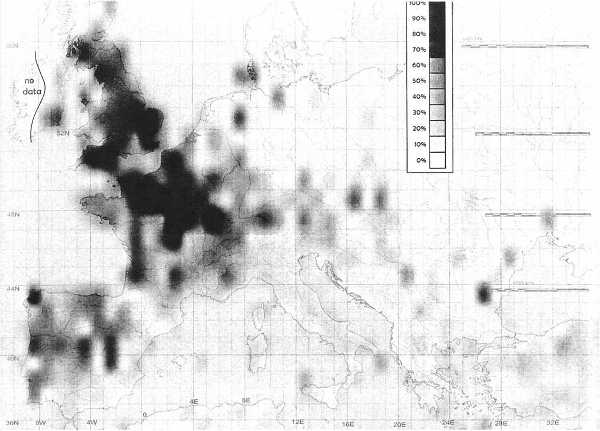
The next map offered here (Fig. 1.2) is Stuart Piggott’s famous plot of the extent of LaTene material culture (Piggott 1965, fig. 134). Since no one would now argue that LaTene material culture can be taken as a surrogate for the extent of the Celts and since it maps a late phase of European connectivity in the 2nd-1st century BC it is largely irrelevant to our consideration of Celtic origins. Its inclusion here is simply to enable these negative points to be made because there is still, lingering in the work of some writers, the belief that LaTene culture = Celts. It is true that many late Celtic speakers adopted LaTene material culture but that is an entirely different matter.
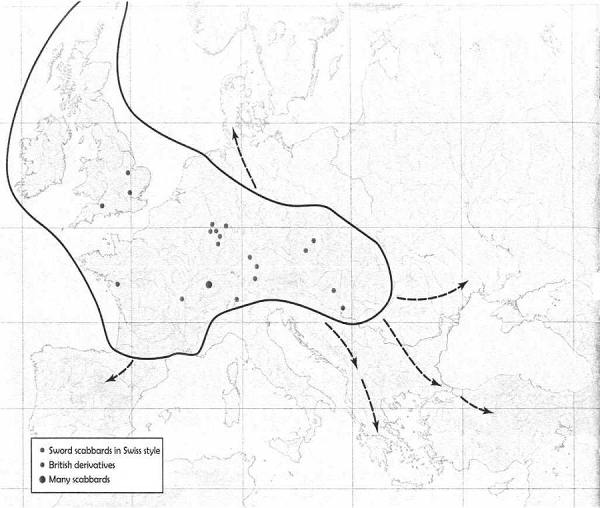
Finally let us consider the early Greek knowledge of the Barbarian world (Fig. 1.3) since it is in the 6th and 5th centuries BC that the Celts are first mentioned. The earliest source is Hecataeus of Miletus who, in the late 6th century, wrote a Periegesis based on a coastal voyage around the Mediterranean and the Black Sea. Three of the surviving fragments mention Celts in the context of coastal towns:
Narbon: trading centre and Celtic city
Massalia: a Ligurian city near Celtica
Nyrax: a Celtic city.
Narbon and Massalia can be directly located and thus confirm the existence of Celts around the Golfe du Lion. Nyrax is more problematical and cannot be located with certainty though it is quite possible that it was a coastal settlement in the same region.
The second source is Herodotus, who wrote his famous Histories c. 430-425 BC. Celts are mentioned in two similar passages:
[19]
For the Ister, beginning in the land of the Celts and the city of Pyrene flows through the middle of Europe. The Celts live beyond the Pillars of Hercules and border the Cynesii [Κυνησιοι], who are the westernmost inhabitants of Europe (Hist. 2.33).
For the Ister flows through all of Europe rising among the Celts who are the westernmost inhabitants of Europe, except for the Cynetes [Κυνητες] (Hist. 4.41).
The source of Herodotus’ information is unknown. It is quite possible that he took the information from Hecataeus while knowledge of the inland tribes of Iberia would have been widely available among the western Greek maritime fraternity by the end of the 5th century. Greek colonists had begun to settle around the Golfe du Lion as early as 600 BC and there is ample archaeological evidence to show that they had explored the east and south coasts of Iberia and were trading with the Tartessians at the port city, now Huelva, which may have been ancient Tartessos.
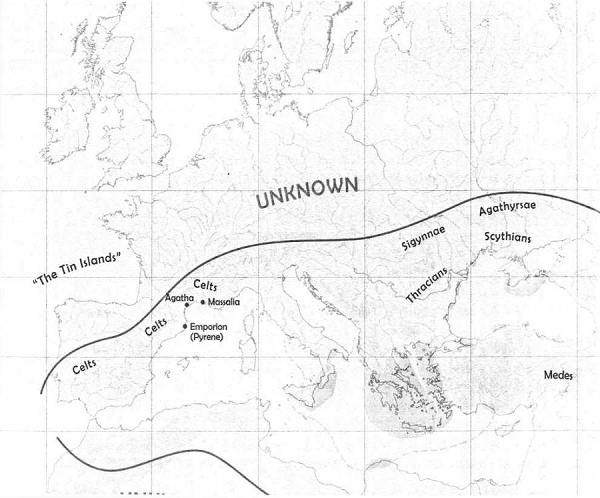
The first scrap of information which Herodotus offers is straightforward — the Celts were one of the tribes living in the extreme west of the Iberian Peninsula. The second is more confused — the Ister (Danube) rose in the land of the Celts near the city of Pyrene. If, as seems likely, Pyrene may be identified as Emporion or at least relates to the Pyrenees (Dominguez 2004, 164), then the simplest explanation is that Herodotus must have been misinformed about the source of the Ister.
Finally there is the 4th-century writer Ephorus. According to the incredulous Strabo:
Ephorus describes Celtica as of excessive size so that most of what we now call Iberia he assigns to it as far as Gades (Geog. IV, IV, 6).
Our earliest Classical sources, then, leave little doubt that they understood that the Celts — presumably identifiable in that they were Celtic speakers — were spread across a wide swathe of land bordering the Greek colonies around the Golfe du Lion and extending west to the Atlantic. That said, it is as well to remember that beyond the littoral zone the world remained largely unknown.
This brief review of the spatial extent of the early Celts has emphasized the tenuous and limited nature of the evidence. At best we can say that the Classical sources demonstrate the presence of Celts in the far west as early as the 6th century BC while John Koch’s study of Tartessian indicates that the Celtic language may have been spoken in the southern extremity of this Atlantic Zone up to two centuries earlier (Koch 2009). Moreover, the density of surviving Celtic place-names is sufficient to demonstrate that the Celtic language was widely spoken along the entire Atlantic Zone. Given these observations it is not unreasonable to put forward the hypothesis that the Celtic language may have developed somewhere along the Atlantic facade of Europe.
It is now time to turn to the archaeological record to see what evidence there is of systems of connectivity and mobility which might be expected to have some bearing on the question.
The Atlantic Zone: its beginnings
The physical characteristics of the Atlantic Zone have been discussed elsewhere in some detail (Cunliffe 2001a, 19-63). Suffice it to say that the Atlantic face of Europe from the Straits of Gibraltar to the Shetland Islands was bound by a complex series of maritime networks which served to link communities together. For the most part it is likely that the maritime networks were short haul with boat crews making journeys only to neighboring coastal communities but the aggregate of these movements was to create a continuous network along which goods and ideas were transmitted. At times no doubt longer journeys — perhaps initially journeys of exploration — were undertaken and some of these might have been repeated at intervals in the interests of maintaining social obligations. Along the north-west coast of North America, for example, sea journeys of up to 500 km were made for ceremonial purposes to reaffirm allegiances between distant communities. The sea, far from being a barrier to mobility actually facilitated it: journeys by land were far slower and could be more dangerous.
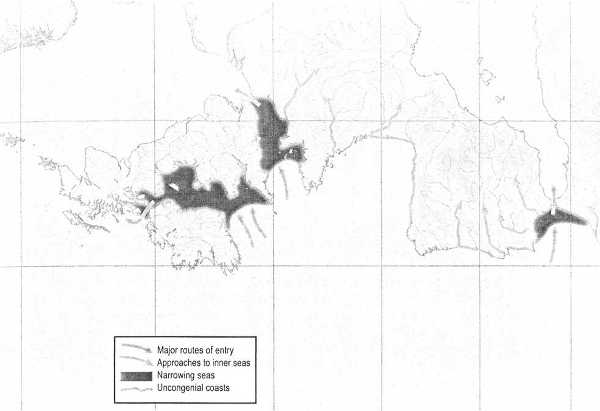
The Atlantic coast was not uniformly welcoming (Fig. 1.4). Long stretches were fringed with sand bars backed by marshland while other sectors were rocky and sheer. But between these inhospitable coasts there were more congenial zones most notably the ria coastlines of north-western Iberia, Armorica, south-west Britain and southern Ireland where a general rise in sea-level has drowned river valleys creating wide, sheltered waterways thrusting deep inland. The estuaries of the major rivers also presented highly congenial points of entry and the rivers themselves provided routes leading deep inland. The west-flowing rivers of Europe from the Guadalquivir to the Rhine allowed the cultural impact of the Atlantic maritime zone to extend far inland.
Maritime networks presuppose the technical skills to build boats and to navigate (Cunliffe 2001a, 64-71). When humans first took to the sea is uncertain but one possibility is that it was during the time that the Atlantic littoral was used as a migration route for hunter-gatherer groups moving northwards as the climate improved following the retreat of the last ice sheets. Certainly by the Mesolithic period dug-out log boats powered with oars are known and it remains a strong possibility that hide boats, built of skins stretched over a light wooden framework, were in operation. Such vessels would have been well within the technical competence of the hunter-gatherer groups and, because of their light construction, provided a highly flexible mode of travel since they could be carried overland with comparative ease.
[22]
The earliest reference we have to hide boats in Atlantic waters is a mention by Pliny in the first century AD but he is quoting a much earlier source, most probably Pytheas who travelled along the Atlantic coasts at the end of the 4th century BC (Cunliffe 2001b, 74-7). The not infrequent references to hide boats by later Classical writers and their persistence in some areas, such as the west coast of Ireland, up to the present day, are an indication of their value, and most likely their predominance, along the Atlantic Zone throughout prehistory.
Already, by the beginning of the 5th millennium BC, there is ample evidence of the small-scale exchange of commodities among coastal hunter-gatherer communities. These early networks, conditioned by the need to maintain systems of social interdependence, set in train the much more vigorous and extensive systems of connectivity that were to dominate the next five millennia of prehistory.
Standing back from the detail of Atlantic prehistory it is possible to distinguish in the changing rhythms of connectivity four broad phases which may be characterized as:
establishing connectivity 5000-2700 BC
escalating mobility 2700-2200 BC
consolidation 2200-800 BC
dislocation and isolation 800-400 BC
Each of these phases will be considered in turn.
| Arrival of the circum-Mediterranean migrants from Africa to Iberia is dated by 2800 BC, conspicuously coinciding with the beginning of escalating mobility. |
Establishing connectivity 5000-2700 BC
The introduction of food-producing economies to the European peninsula is a well-studied phenomenon and the outline of the process is not in doubt. In summary, after the initial introduction of the Neolithic package to Greece in the 7th millennium
BC the economic system spread rapidly across middle Europe reaching north-western France c. 5300 BC and throughout the Mediterranean, as the result of a number of swift seaborne movements (Fig. 1.5). By the second half of the 6th millennium this Mediterranean advance had led to the establishment of two Neolithic enclaves on the Atlantic coast of Iberia, one in the south-western Algarve and one between the Tagus and Mondego estuaries: by about 4800
BC most of the coastal zone between the two enclaves had adopted food-producing economies. While the nature of this early Neolithic settlement
(Neolithic in terms of farming, not type of stone tools) of the Atlantic Zone has been much debated (Zilhäo 1993; 2000; Arias 1999), the simplest explanation is that it resulted from the intrusion of new people coming from the Mediterranean
(Y-DNA Hg E, sea people). Barely 500 years separated the earliest colonists setting out from the eastern coasts of the Greek peninsula and the arrival of settlers in Portugal.
[23]
by which the Neolithic (i.e. farming) way of life spread through Europe from the southern Balkans,
the overland spread via the Danube and North European Plain and the Mediterranean route by sea,
ultimately to the Atlantic coast of Iberia
– Linearbandkeramic culture
– Starcevo and llied cultures
– Impressed wares
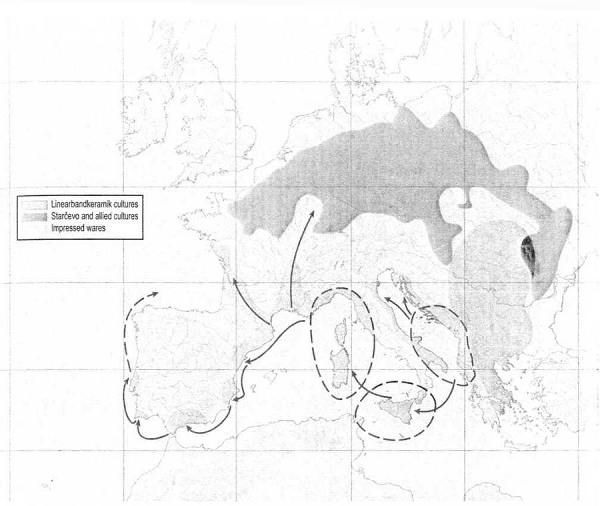
The spread of the Neolithic system into the Atlantic coastal regions of France is less well understood. One route was from the Mediterranean along the Garonne-Gironde to the Atlantic, the other led via the middle European route to Normandy and the Channel Islands. There remains the possibility that the Atlantic coastal zone may also have received settlers from the Portuguese enclaves but there is no conclusive evidence of this. Britain and Ireland received Neolithic influences from both the east and the west. The eastern route across the Channel brought people from the northwestern French region (Sheridan 2007) while the western (Atlantic) route saw first the arrival of domesticated animals, quite possibly in the context of gift exchange (Tresset 2003; Woodman & McCarthy 2003) followed by more specific cultural characteristics
such as pottery styles and burial rites (Sheridan 2003a; 2003b). Thus, in a comparatively brief
period, from 5500-3800 BC, the entire Atlantic coastal region had moved from a hunter-gatherer
economy to one of settled food production. The processes of that transition were complex and varied
but there can be no reasonable doubt that they involved the movement of people as well as livestock
and seed corn and that the sea played a significant role in the rapidity of the transformation.
[24]
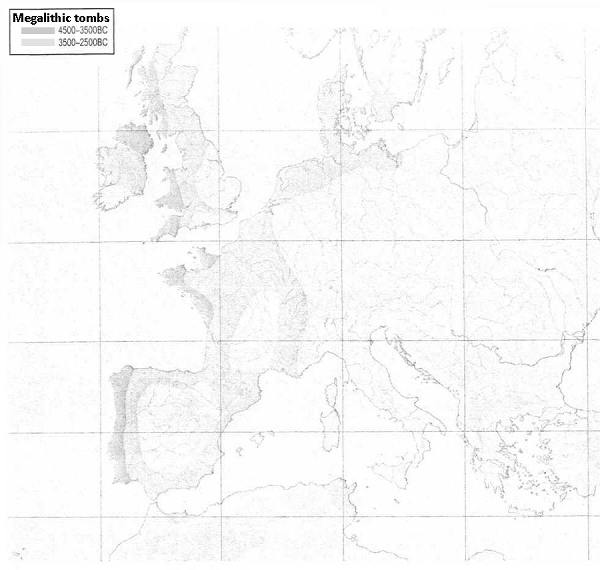
The continued significance of the seaways in maintaining social and cultural contact is evident in the archaeological record. The most dramatic example is that offered by the spread of passage graves along the Atlantic facade (Fig. 1.6). The concept of the stone-built passage grave probably originated in the Tagus region in the early centuries of the 5th millennium (BC) and spread rapidly to Armorica and later further north to Ireland and western Britain, reaching the Orkney Isles by 3000 BC. Each region developed its own interpretation of the basic concept but all shared in common an underlying belief system and cosmology as well as adopting similar architectural and artistic styles. While the old idea of ‘megalithic missionaries’ plying the Atlantic coasts is no longer in favor, the evidence suggests that the Atlantic maritime networks were sufficiently active in the 5th and 4th millennia for ideas and beliefs to flow freely creating a degree of cultural cohesion over considerable distances.
| The dating of megalithic graves by 5th mill. BC conflicts with genetically traced concept of
Kurgan circum-Mediterranean migration from the N. Pontic 4500- 4000 BC/6500-6000 ybp to Iberia and
specifically to Tagus with arrival date of 2800 BC/4800 ybp. If megalithic graves were spread by
sea-faring Y-DNA Hg E farmers, they, first, have to originate in the Balkan/Mediterranean area, and
second, be unrelated to the Y-DNA Hg R1b Kurgans, who reached Iberia 2 millennia later. If, on
the other hand, megalithic graves are a type of the kurgan graves, their appearance should be dated
by 2 millennia later, by early 3rd mill. BC, and their spread attributed to the R1b Celtic Kurgans.
Kurgans are an attribute of the reincarnation concept now termed Tengiism, they are travel supplies for the round trip for reincarnation and back, primarily jars of food provisions, weaponry, and tools. This powerful concept is attested by the continuous construction of kurgans from the 4700 BC (Samara, Khvalynsk, Pit Grave “Kurgan” archaeological cultures) to the historical modernity. |
Superimposed on these broader systems of maritime connectivity it is possible to identify a number of regional systems recognizable through the distribution of characteristic artefacts, most notably polished axes. Polished stone axes made from distinctive stone sources were frequently distributed over wide areas implying that the axe had a social value which greatly exceeded its practical utility. Axes made from a dolerite from quarries identified at Seledin, Plussulien in central Brittany seem to have been particularly valued (Le Roux 1999). They account for more than 40 per cent of the known axes in Brittany and were distributed widely across north-western France particularly along the Loire valley and into the river systems of the Seine. Another Breton axe type — this time a shaft-hole axe made of hornblendite from quarries at Pleuven, Quimper — shows a very similar distribution pattern though the actual number of specimens is fewer (Giot & Cogne 1955). Since the axes are likely to have passed from hand to hand as valued items within systems of gift exchange, the distribution patterns reflect the social networks which bound communities together. While the sea was evidently important it is clear from these examples that, already by 3000 BC, the major Atlantic-flowing rivers had become an intimate part of the system.
The extent of the western European networks is no better demonstrated than by the distribution of the magnificent axes made from jadeite coming from a limited number of sources in the eastern Alps (Petrequin et al. 2008). Axes were manufactured here between 4700 and 3800 (BC) and were distributed widely throughout western Europe reaching northern Spain, Scotland and Ireland (Fig. 1.7). The fact that it was the larger and more finely finished versions that travelled the furthest is a sure indication that they were transmitted as items of high prestige. What is significant from our point of view is that the distribution pattern of the axes shows up in stark relief the networks of connectivity which bound the disparate western European communities together. Some of the routes are those along which the Breton axes passed, though in the reverse direction.
The distribution vividly displays the exchange networks then in operation.
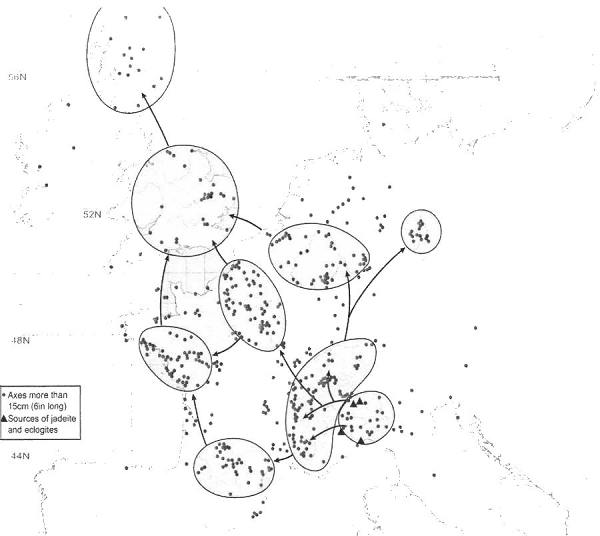
It would have been possible to multiply examples of distribution networks, distinguishable through artefact distributions, across the whole face of western Europe but the main point has been well made by the selected examples. In the period from about 5000
BC to about 2700 BC, during which time a food-producing economy was established throughout the region, social networks binding communities continued to expand. The Atlantic seaways provided a major channel of communication but so too did the major rivers flowing into the ocean. These offered routes that led deep into Europe eventually joining with the Rhone, the Po, the Rhine and the Elbe. The maximum extent of the northern part of this network is vividly demonstrated by the distribution of jadeite axes but similar riverine networks also drew much of the Iberian Peninsula into the Atlantic system.
[26]
Systems of connectivity of this kind do not necessarily imply extensive mobility: beliefs, values and commodities can easily pass over considerable distances through the social mechanisms that had come into being to maintain harmony between neighboring communities. What is important is that the networks allowed cultural characteristics to be shared over considerable distances, between peoples who may have had no direct knowledge of each other, leading to convergences in culture over extensive areas. This longue duree of connectivity, coming into being over several millennia, created a structure which was to influence developments in the next period when the mobility of people and commodities was to increase dramatically.
| Except for megalithic graves, the pre-2700 BC face of western Europe mirrors that of the central Europe's “Old Europe” before the first wave of Kurgan invasions at 4400-4300 BC. The egalitarian placid farming communities live their neighborly lives undisturbed, unperturbed, and stationary. After 2700 BC the face of western Europe resembles that of the central Europe after the first wave of Kurgan invasions. The tempo accelerates, disturbances and perturbations mount, and the life becomes mobile. |
Escalating mobility: 2700-2200 ВС
In the 3rd millennium much of the western part of Europe was caught up in what has been referred to as the ‘Beaker phenomenon’ which saw the appearance of a distinctive type of pottery beaker often associated with recurring sets of grave goods including copper knives and archers’ equipment in some regions accompanying single burials. The phenomenon has been variously interpreted (e.g. Clarke 1976; Lanting & Van der Waals 1976; Harrison 1980) but now, with the availability of high precision radiocarbon dates and a more nuanced study of the associated material culture, a new consensus is beginning to emerge.
The earliest form of Bell Beaker — the so-called Maritime Bell Beaker — probably originated in the vibrant copper-using communities of the Tagus estuary around 2800-2700 BC and spread from there to many parts of western Europe (Case 2007). As the map (Fig. 1.8) indicates the initial movements were maritime. A southern move led to the Mediterranean where ‘enclaves’ were established in south-western Spain and southern France around the Golfe du Lion and into the Po valley. A northern move incorporated the southern coast of Armorica with further, less well defined, contacts extending to Ireland and possibly to central southern Britain. What these archaeological distributions mean in terms of the physical movement of people it is difficult to say, but such are the distances involved that it is difficult to see how the transference of such distinctive sets of cultural values and beliefs could have taken place without significant degree of human mobility and perhaps some element of enclave settlement. This is quite different from the simple down-the-line exchanges we have considered earlier.
the crucial nodes in this network were the Tagus estuary and the Morbihan, while major hinterland routes followed the navigable rivers.
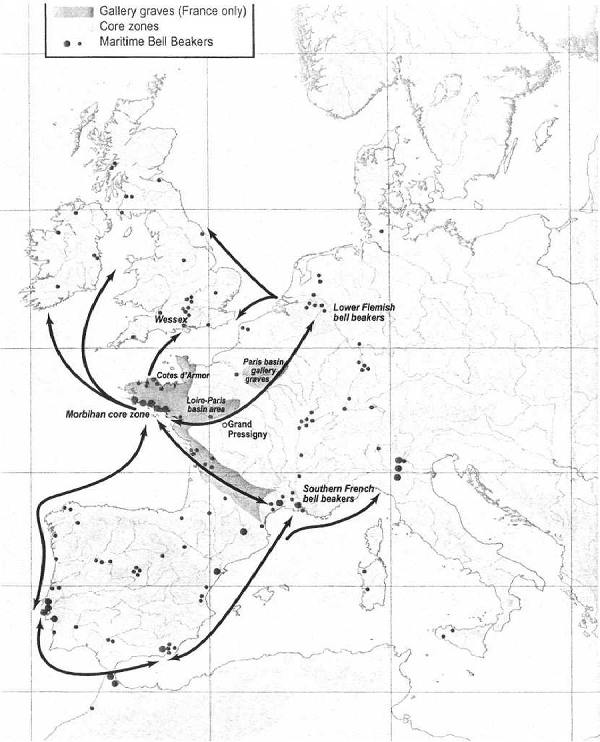
One possible context for the increased mobility may lie in the development of a copper technology which was becoming established at this time in the west. The earliest copper production took place in the Tagus region and spread from there to the other areas. The earliest copper production in Ireland, identified at Ross Island in the period 2400-2200, was associated with early Beaker pottery (O’Brien 2004, 451-78). Here the local sulpharsenide ores were smelted to produce the first copper axes used in Britain and Ireland. The same technologies were used in the Tagus region and in the west and south of France (Ambert 2001). The evidence is sufficient to support the suggestion that the initial spread of Maritime Bell Beakers along the Atlantic and into the Mediterranean, using the sea routes that had long been in operation, was directly associated with the quest for copper and other rare raw materials.
The enclave established in southern Brittany was linked closely to the riverine and landward route via the Loire and across the Gatinais to the Seine valley and thence to the Lower Rhine. This, as we have seen, was a long-established route reflected in early stone axe distributions and it was via this network that Maritime Bell Beakers first reached the Lower Rhine in about 2700
— 2500 (BC). Other materials passing along the exchange networks at this time were the honey-colored Grand Pressigny flint mined not far from Poitiers and, in reverse direction, amber from the coast of Jutland. Grand Pressigny flint also found its way to the western Alps in the period 2800-2400
BC. It was probably along the ancient western Alpine routes, used to distribute jadeite axes in the 4th millennium, that Maritime Bell Beakers were transmitted to the Po valley.
[28]
The Lower Rhine region had, by 3000 BC, adopted a burial rite characterized by single inhumation accompanied by a beaker decorated with cord zone impressions and, frequently, by a perforated, stone battle-axe. This cultural package was characteristic of belief systems which extended across the North European Plain into Russia. The arrival of the Maritime Bell Beaker from the west a century or two later initiated a period of borrowing and experimentation in what has been called the Primary Bell Beaker/Corded Ware contact zone and cultural traits developed here, such as single burial and the shaft-hole axe, were transmitted westwards along the exchange networks from the Rhine to the Loire (Salinova 2000). It was from this fusion zone that the modified Beaker package spread northwards across the Channel to Britain (Needham 2005).
| The first Kurgan wave rolled into Central Europe in 4400-4300 BC, bringing with it its Kurgan tradition. The first circum-Mediterranean Kurgan migrants left for Caucasus in 4500-4000 BC. By that time, the Kurgan tradition had lasted for 2-3 millennia, or 80-120 generations. The synchronous versions propagated by very different routs, the overland and the circum-Mediterranean route that reached Europe again in 2800 BC. Soon afterward, by 2500 BC, two flows of Kurgans met again, after a 1500-2000 years or 60-80 generations of separation. Even if initially they originated from a single tribe, and could not intermarry because of the laws of incest, at the time of encounter they were very different people, were much alien to each other, had mutually incomprehensible vernaculars, and conceptually could intermarry without violating the laws of incest. |
The maximum extent of the Bell Beaker complex in the period 2700-2200 BC is shown in sketch form in Figure 9. It extends northwards to the Elbe, eastwards as far as the Danube Bend and into northern Italy and western Sicily but it was by no means uniform and there were tracts where the Beaker package was totally unknown and indigenous culture continued uninterrupted (Heyd 2007): the dense Bell Beaker distributions tend to favor the major corridors of communication by sea and by river.
What all this means in terms of population mobility is a fraught but fascinating question. Archaeologists are reluctant to return to old models of ‘Beaker Folk’ rampaging across Europe, but that there was a high level of human mobility at this time is not in doubt as numerous studies of stable isotopes in human bones are beginning to demonstrate. The now-famous Amesbury Archer, buried with all his finery within sight of Stonehenge around 2200 BC, was a specialist coppersmith who, according to the percentage of stable isotopes in his teeth, had probably spent his childhood in the western Alps before making the long journey to Wessex (Fitzpatrick 2002). Other studies have shown that surprisingly high percentages of people buried in Beaker-period cemeteries were not born in the region of their death (Price et al. 1998; 2004). It will be some time before the many analyses of this kind, now under way, are published and assessed but the evidence is increasingly pointing to a much higher degree of mobility than had previously been allowed.
Mobility of this kind need not be surprising. We have already seen how, over a period of some two thousand years, complex networks of connectivity had already grown up binding distant communities in western Europe together in loose systems involving socially embedded exchange. The flow of commodities through trade networks was probably on a modest scale and actual movements of people circumscribed. What we see in the Bell Beaker phenomenon of the period 2700-2200
BC is a rapid escalation of these processes. The volume of commodities on the move was now considerable, greatly exacerbated by the new demand for metals
— copper, gold and tin — much of which was extracted in the metal-rich Atlantic Zone. This was also a period of fast-developing technologies. The extraction of metal required expertise, so too did its successful alloying. It is worth remembering that the first regular tin-bronze in western Europe is found in the Atlantic Zone where the two components, copper and tin, were found in close proximity (Pare 2000, fig. 1.1). Metalworkers were the new men whose skills were revered and whose presence was worth soliciting. In a fast-changing world of this kind population mobility would have greatly increased.
[30]
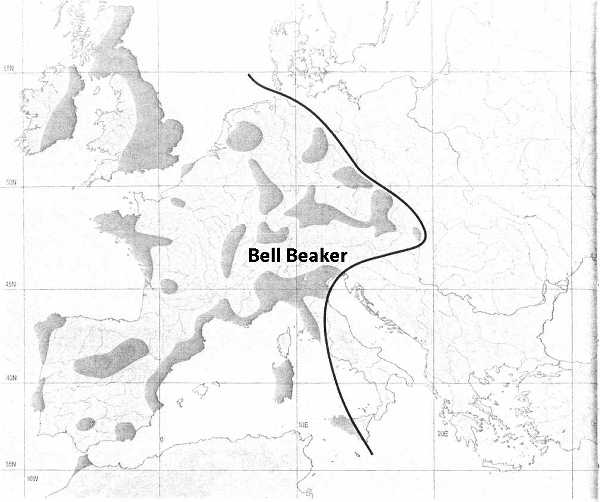
One further point deserves consideration. The 3rd millennium also saw considerable changes in eastern European society, perhaps the most notable being the intrusion of nomadic horse-riding peoples coming from the Pontic steppe to settle along the Lower Danube valley and on the Great Hungarian Plain within the Carpathian Basin. The Late Yamnaya
(i.e. Pit Grave) culture, as it is known, appeared in Hungary around 2700
BC bringing well-trained riding horses from the steppe and a technology of vehicle building to confront the Single Grave/Corded Ware culture of the North European Plain and the Bell Beaker communities of the west (Harrison & Heyd 2007, 193-203). The interactions which must have taken place on the interfaces of these different worlds (Fig. 1.10) would have brought lasting changes to all those involved. It is no exaggeration to say that the middle of the 3rd millennium was a period of movement and interchange quite unlike anything that had gone before or was to come for another two millennia.
[31]
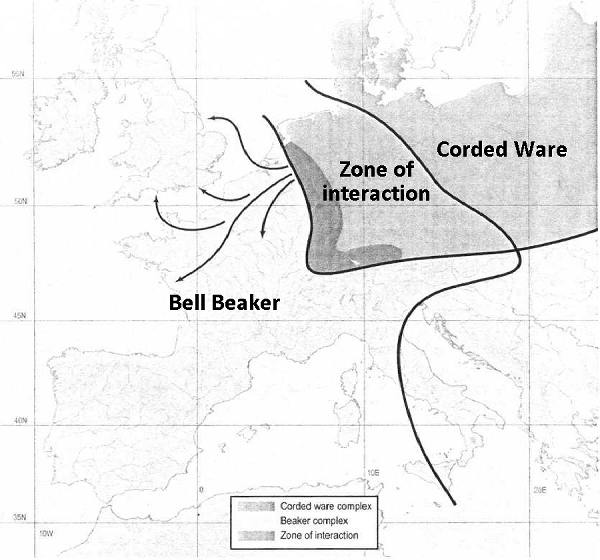
Consolidation: 2200-800 ВС
For western Europe the period after about 2200 BC was one of consolidation. There is little
evidence of large-scale population mobility but regional networks continued to operate, often on a
more intensified scale, leading to the development of distinct regional cultural zones. One good
example of this is the English Channel and southern North Sea zone. At the end of the 3rd millennium
interaction between the Continent and Britain introduced various elements of the evolved Beaker
package to the island, no doubt using the existing maritime networks (Needham 2005).
[32]
Stuart Needham has further developed his study of these activities by arguing that the mastery of the sea at this time became a mark of elite status and that the surprisingly large numbers of cups made of precious materials, which concentrate in these maritime regions, may have been a symbol of these elites in the early centuries of the 2nd millennium BC. If this is so then the sea itself, rather than being a space between territories, becomes a territory in its own right — in Needhams phrase a maritory — over which the elite demonstrate their command (Needham 2009). The hypothesis, though difficult to prove, has distinct attractions.
Throughout the 2nd millennium BC and into the 1st millennium (BC), the maritime connectivity between the south-east of Britain and the adjacent Continent, from Lower Normandy to the Low Countries, intensifies. This is shown by the exchange of bronze implements between the two regions (O’Connor 1980) and also by very close similarities which develop in material cultures, particularly pottery, and in settlement form and layout (Cunliffe 2009). Cyril Marcigny, who has recently surveyed the Continental evidence, writes of a composante culturelle Manche-Mer du Nord embracing both sides of the Channel (Marcigny et al. 2002; 2007).
Cultural similarities of this kind, which are now becoming apparent as the French archaeological record continues to be explored and published, imply far more than simple networks maintaining stable relationships through the exchange of material gifts. What we are seeing here are communities creating much closer social ties, involving the movement of people, through marriage and other bonds of obligation which hold lineages together.
This one small study focusing on the English Channel may well be typical of the intensification that was going on throughout the Atlantic Zone in the 2nd and early 1st millennia (BC). It has long been recognized that the Atlantic Bronze Age reflects a time when communities along the entire Atlantic face of Europe were engaged in the exchange of bronze metalwork on a large scale with items being exported over considerable distances. Sicilian shaft-hole axes found their way to Armorica and the Solent coast while lunate spearheads of Irish manufacture were found in collections of bronze-work deposited in the sea off Huelva in south-western Iberia. Viewed overall the Atlantic Bronze Age has the appearance of being a vigorous system of exchange binding maritime Europe from Iberia to Shetland (Chevillot & Coffyn (eds.) 1991; Jorge (ed.) 1998).
But we are looking at far more than just the bulk movement of metal. Embedded within this system lies the sharing of social values and belief systems. The armaments of the warrior, so vividly represented on the carved stelae found in south-western Iberia, depicting the long slashing sword, the spear and the circular shield (Harrison 2004), recur throughout the entire Atlantic Zone while the accoutrements of the hearth
— the bronze cauldron, the flesh hook and the roasting spit — are equally widely dispersed. These items are the physical manifestation of the feast which would have played a central role in the display of hospitality expected of the elite. While the bronzes found the length of Atlantic Europe can, at one level, be regarded as scrap metal dedicated to the deities, at another they reflect the very being of Bronze Age society
— its values and its practices.
[33]
Dislocation and isolation 800-400 BC
The networks of exchange which developed along the Atlantic seaways during the Late Bronze Age (c. 1300-800 BC), and extended deep into the Continent along the river valleys, intensified as time progressed but in the 8th century BC the old system seems to have collapsed. The disposal of bronze in large ‘hoards', which had characterized the system for centuries, came to a complete end. Many reasons have been suggested for this comparatively sudden transformation. The matter is complex and cannot be considered in detail here but the likelihood is that a number of factors converged to exacerbate the change. One, of relevance to the present discussion, is the expansion of Phoenician commercial interests into the Atlantic following the establishment of a permanent colonial port-of-trade at Gadir (modern Cadiz) (Aubet 1993). The 8th and 7th centuries saw the creation of Phoenician enclaves down the west coast of Africa as far south as Essaouira and northwards along the coast of Iberia at least as far as the Mondego estuary. The intention clearly was to command control of the wide range of commodities that were available along these coasts, most particularly gold, silver, copper, tin, ivory and ostrich shell, and to draw them, through Gadir, into the Mediterranean trading systems. Such a development cannot have failed to have dislocated the old Atlantic system by appropriating the whole of its southern sector. As a result western Iberia was now drawn into the Mediterranean sphere.
For a while north-western France, Britain and Ireland remained in close contact, but after about 500 BC Ireland seems to have fallen out of the network and remained isolated until probably as late as the 1st century BC. Southern Britain and the adjacent Continent maintained contact but even that seems to have decreased in intensity after the 4th century and Britain remained in comparative isolation until the 1st century BC when the bow wave effects of the approaching Roman Empire began to make themselves felt (Cunliffe 2009).
Some generalizations and some questions
This very rapid and highly selective overview of Atlantic European prehistory has been offered to try to redress the still deeply ingrained prejudices — based on the old ex Oriente lux hypothesis — that all things good and innovative flowed from east to west and that the poor benighted communities of the Atlantic facade lived in a peripheral gutter into which benefits from 'higher' cultures were occasionally flushed. As the rich archaeological record now shows, nothing could be further from the truth. Throughout much of prehistory the Atlantic communities were highly innovative and relatively self-supporting.
series editor: John T. Koch

The Celtic Heroic Age: Literary Sources for Ancient Celtic Europe and Early Ireland and Wales, ed. John T. Koch with John Carey (2003) Pp. x + 440 ISBN 1-891271-09-1
A Celtic Florilegium: Studies in Memory of Brendan О Hehir, ed. Kathryn Klar, Eve Sweetser, and Claire Thomas (1996) Pp. xxxvi + 227 ISBN 0-9642446-3-2-
0-9642446-6-7
lldanach Lldirech. A Festschrift for Proinsias Mac Cana, ed. John Carey, JohnT. Koch, and Pierre-Yves Lambert (1999) Pp. xvii + 312 ISBN 1-891271-01-6
Yr Hen Iaith: Studies in Early Welsh, ed. Paul Russell (2003) Pp. viii + 224 ISBN I-891271-10-5
Landscape Perception in Early Celtic Literature, Francesco Benozzo (2004) Pp. xvi + 272 ISBN I-891271-II-3
Cin Chille Cuile-Texts, Saints and Places: Essays in Honour of Padraig 0 Riain, ed. John Carey, Maire Herbert, and Kevin Murray (2004) Pp. xxiv + 405 ISBN I-891271-13-X
Archteologia Britannica: Texts and Translations, Edward Lhwyd, ed. Dewi W. Evans and Brynley F. Roberts (2009) Pp. xii + 262 ISBN 978-1-891271-14-4
Ireland and the Grail, John Carey (2007) Pp. xxii + 421 ISBN 978-1-891271-15-1
An Atlas for Celtic Studies: Archaeology and Names in Ancient Europe and Early Medieval Ireland, Britain, and Brittany, JohnT. Koch with Raimund Karl, Antone Minard, and Simon 0 Faolain (2007) Pp. viii + 216 ISBN 978-1-84217-309-1
Tartessian: Celtic in the South-west at the Dawn of History, JohnT. Koch (2009) Pp. viii + 184 ISBN 978-1-891271-17-5
Moment of Earth: Poems & Essays in Honour of Jeremy Hooker, ed. Christopher Meredith (2007) Pp. xvi + 313 ISBN 978-I-891271-16-8
Celtic from the West: Alternative Approaches from Archaeology, Genetics, Language and Literature, ed. Barry Cunliffe and John T. Koch (2010) Pp. xii + 383 ISBN 978-1-84217-410-4